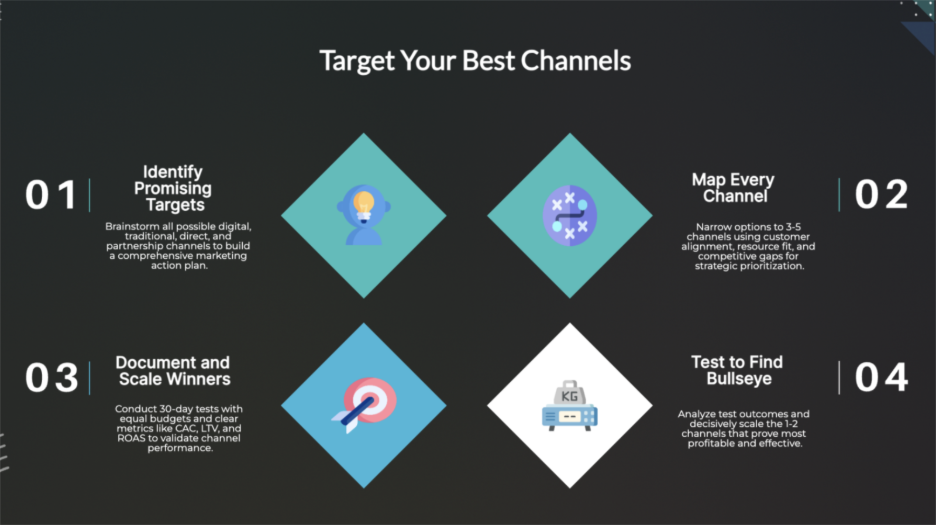.jpg)
.jpg)
TL;DR
"Strategy without tactics is the slowest route to victory. Tactics without strategy is the noise before defeat." - Sun Tzu, author of The Art of War
Retail marketing today often feels like that noise. Most retailers spread their dollars across Facebook ads, Google campaigns, influencer partnerships, email blasts, and content creation, taking advice from friends, all in the hope that something will stick. Guided by anecdotes, online tips, or gut instinct, they end up wasting resources without knowing which effort truly works.
Over time most merchants realize- none of these work well.
But smart retailers take a different path. They use the bullseye framework, a step-by-step way to find the right marketing channels systematically. No guessing, no wasted spend, just focused effort that leads to real growth.
It’s the same idea behind how top e-commerce merchants place the right bets by choosing the few channels that truly matter instead of trying to do everything at once. The method is straightforward, but like most deep work, it often gets pushed aside for months, sometimes years, before teams finally act on it.
“Marketing takes time, money, and preparation. One of the best ways to stay on schedule and on budget is to make a marketing plan. It describes the actions you’ll take to persuade potential customers to buy your products or services”. - U.S small business administration
Gabriel Weinberg and Justin Mares, the founders of DuckDuckGo, studied how successful companies acquire customers. Their research revealed a clear pattern: the best companies don’t try everything. They focus on one or two channels that perform exceptionally well. But how do you really find them?
That’s where the bullseye framework for retailers comes in. Based on their research and experience, Weinberg and Mares distilled everything into a simple but thorough process- the bullseye framework.
The framework is built around three rings:
Start by listing every possible channel. Yes, even the “are you serious?” ideas. The point is to create a wide marketing action plan that covers digital, traditional, direct, and partnership options.
Narrow the long list to 3–5 promising channels. This is where tough choices are made. The right picks depend on three things:
Inner ring : This is where testing begins. Run short, structured experiments to see which channels truly delivers results. While it’s easier said than done, this stage separates hopeful spending from profitable growth.
The goal is systematic marketing channel selection: moving from outer ring to bullseye, where the channels that actually work are discovered and scaled.
Because most retailers jump to execution without really understanding which channels fit their customers, products, and constraints- they can spend months without figuring out the why behind their struggle.

List every marketing channel available to retailers. Don't edit yet. The goal is complete brainstorming. Here’s a list to help you get started, though by no means is this list comprehensive-
Digital: Google Ads, Facebook advertising, Instagram, TikTok, email marketing, content marketing, SEO, affiliate programs, influencer partnerships, podcast advertising, YouTube, LinkedIn, Twitter, Pinterest.
Traditional: Print ads, radio, TV, direct mail, billboards, trade shows, retail partnerships, public relations, speaking events, community involvement.
Direct: Sales teams, retail locations, pop-ups, networking, referral programs, customer service touchpoints.
Partnership: Wholesale relationships, distributor networks, cross-promotions, strategic alliances.
Most retailers can list 30–40 possible channels, and the sheer number can feel overwhelming. That’s intentional; you need the full picture before narrowing it down. Sometimes the most powerful growth comes from areas people overlook, like customer feedback, which often separates great businesses from good ones.

Filter candidates from outer ring to middle ring using three criteria:
Customer alignment: Where do your ideal customers really spend their time? Think deeply about this. If needed, really go ahead and find data to back it up. Luxury jewelry brands shouldn't start with TikTok. Teen fashion retailers shouldn't lead with LinkedIn. No, it's not purely common sense, there's data to support it.
Resource fit: Which channels match your team's skills and budget? Video marketing requires different capabilities than email campaigns. Influencer partnerships, for example- need relationship management skills.
Competitive gaps: Where are competitors weak or absent? Sometimes the best opportunity lies in ignored channels. And yes, this is where- "see, I told you it's not that crazy" kind of ideas really shine.
The key is discipline: 3–5 channels only. More than that, and you’re not really prioritizing, you’re hedging.
Example for outdoor gear retailer:
These may start from intuition, but critical thinking and market data make them actionable. The middle ring forces retailers to make hard choices, cutting good options so the best ones get focus. That’s the essence of marketing channel prioritization.

Testing separates smart retailers from hopeful ones. This is the stage where you start designing focused 30-day experiments for each middle ring channel. Each of these need your proper attention, time and resources- so plan wisely. Don't just commit for namesake. And yes, hold yourself accountable to give it your best shot (even with limited resources).
What Does a Smart Test Look Like?
Retailers often struggle because they “half-test” channels, running inconsistent campaigns or spreading budgets unevenly. Instead, follow these four principles:
Most retailers discover 1-2 channels significantly outperform others. Those become your bullseye channels. And over time you will see that they get at least 70% of your growth spends, even as you keep experimenting with the other non-prioritized channels from the earlier stage (see- nothing really goes to waste)

It's not full-proof, but data tells us that some retail models favor different channels based on business category. Typically-
Yes, geography matters too. Local retailers prioritizing community partnerships and local SEO also get great results because most national brands focus their ad spends on scalable digital channels. But, yes, this list isn't the only channel you should choose, it's just a starting point/consideration list.

Even with a proven process like the bullseye framework, it’s easy to slip into patterns that sabotage results. Here are the most common mistakes to avoid:
Success requires discipline. Start with your outer ring brainstorm, narrow to middle-ring candidates within a week, and have tests running before the month ends.
The purpose of the bullseye framework for retailers is to force systematic marketing channel selection. Instead of chasing every new opportunity, you zero in on what drives actual results.
Once a retailer masters one channel, new doors open:
Over and over, the data shows: speed matters, but depth creates durability. The bullseye framework ensures you prioritize with confidence, eliminating doubts that stall growth.
As Steve Jobs once said, “Innovation is saying no to a thousand things.” The Bullseye Framework gives you the confidence to say no to distraction, so you can focus on the few channels that truly move the needle.